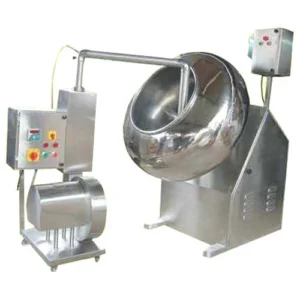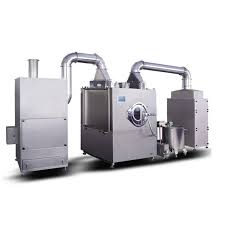Pharmaceutical Coating Machine
Get your pharmaceutical coating machine from Qualipak and have precise control of the coating. Improve efficiency and quality of production in pharmaceuticals. It is designed to achieve uniform coating, thus facilitating drug delivery. Take your manufacturing practices to new levels with our advanced technology. For unrivalled innovation in pharmaceutical equipment go for Qualipak only.
Introduction of Pharmaceutical Coating Machine
Within the pharmaceutical industry, drug quality, efficiency and safety are of utmost importance. These factors are maintained by applying protective coating on various pharmaceutical products using pharmaceutical coating machines. This comprehensive guide will address different aspects of pharmaceutic coating machines including their types, working process, applications, functions, benefits, future trends as well as maintenance and training.
Types of Pharmaceutical Coating Machines
Different types of pharmaceutical coating machines exist each serving specific requirements and production capacities. These include:
Film Coating Machines: They are used for the application of thin polymer-based coatings on solid dosage forms such as pellets or granules in tablets or capsules. They ensure uniform thickness for these coatings and can be used with both aqueous and solvent-based coating formulations.
Sugar Coating Machines: Sugar coating is a traditional process that maintains the aesthetics of tablets while hiding their unpleasant flavours and smells.
Enteric Coating Machines: They are designed for use in applying enteric coatings to tablets or capsules that cannot be absorbed before arriving at the small intestine where they dissolve since they resist stomach acidity.
Fluid Bed Coating Machines: In the fluid bed coating machine’s case; a coat is applied onto all particles of drugs through a fluidized bed mechanism. Its advantages include even coat distribution within a short period of drying time as well as allowing individual control over other parameters forming part of the entire procedure.
Pan Coating Machines: Pan coating machines are also referred to as conventional coaters because they employ rotating pans into which various solutions are poured during tablet coating processes depending on batch size differences. They work effectively regardless of the batch sizes.
Working Processes of Pharmaceutical Coating Machines
The primary stages involved when using a pharmaceutical coater comprise preparation, application (coating), drying and curing. Here is a simple outline:
Preparation: Before beginning the process of coating any mixture solution or suspension meant for this purpose should be prepared according to its formulation requirements which may involve mixing polymers and plasticizers, pigments among others together with their suitable solvents or aqueous solutions.
Coating Application: The pharmaceutical products to be coated are fed into coating equipment such as pans, drums or fluidized beds according to the kind of coater. Then the coating solution is sprayed onto the moving surfaces of the products ensuring that they have been covered equally.
Drying: After one applies a coating on tablets, capsular etc. these items should undergo a drying process to get rid of any solvent or water in them. This can be done using heated air passed over surfaces which in turn evaporates some solvents facilitating the formation of solid film-like coatings.
Curing (Optional): In some cases the enteric coating going through curing is recommended since it improves both toughness and stability. Curing may require exposing coated articles at a specific temperature and humidity for a fixed period.
Applications of Pharmaceutical Coating Machines
Pharmaceutical coating machines are used in many applications throughout the industry. Examples are:
Tablet Coating: This involves applying a thin layer (film) made up of polymer or sugar on tablets to improve taste, appearance, and swallowability and shield against moisture, light and chemical degradation.
Capsule Coating: Coating hard gelatin capsules to mask bad tastes or smells, make swallowing easier and improve stability.
Pellet Coating: Coating pellets with active pharmaceutical ingredients (APIs) to control release profiles, enhance bioavailability, or provide enteric protection.
Modified Release Formulations: Coating tablets or pellets with specialized coatings that deliver modified release profiles such as extended-release, delayed-release, or pulsatile-release formulations.
Functional Coatings: Applying coatings with functional properties like moisture barrier coatings, taste-masking coatings, and enteric coatings to meet specific formulation requirements.
Functions of Pharmaceutical Coating Machines
Pharmaceutical coating machines serve several essential functions in the drug manufacturing process including:
Enhanced Product Stability: By coating pharmaceutical products they are protected from environmental factors such as moisture, light and oxygen hence improving their stability and shelf life.
Improved Patient Compliance: In addition; the use of coats can hide unpleasant flavours or odours found in some drugs thereby making them more tolerable thus increasing acceptability by patients and achieving greater adherence to medication regimens.
Controlled Drug Release: Specialized coatings enable pharmaceutical companies to regulate the rate at which active ingredients are released from dosage forms hence facilitating sustained release, prolonged action or targeted delivery of drugs.
Uniform Coating Distribution: By minimizing variability in coating thickness on pharmaceuticals during the application of the coating materials onto them, a uniform distribution is achieved leading to the consistent product quality of coated dosage forms
Customization and Flexibility: Depending on the specific formulation requirements they have; manufacturers can use these machines for different kinds of coating formulas thus customizing it.
Benefits of Pharmaceutical Coating Machines
The use of pharmaceutical coating machines offers several benefits to drug manufacturers including:
Improved Product Quality: The quality is enhanced by ensuring uniform application of coats using machines which also makes them consistent all through.
Cost Efficiency: This leads to reduced labour costs in manufacturing low wastage quantities due to automated coat production thus drug manufacturers find these machines cost-effective.
Enhanced Patient Experience: Coated dosage forms taste better, look good and are easy to swallow which results in improved patient compliance and satisfaction.
Diverse Formulation Options: Pharmaceutical coating machines support a wide range of coating formulations and techniques, allowing manufacturers to explore various formulation options to meet specific product requirements.
Regulatory Compliance: The machine is equipped with advanced process control features for meeting regulatory standards; hence high-quality pharmaceutical products can be produced using them.
Maintenance and Training of Pharmaceutical Coating Machines
Maintenance of pharmaceutical coating machines is very important for their effective working and longevity. Proper maintenance practices prevent downtime, reduce the risk of defects and maintain product quality. Below are some important maintenance activities for pharmaceutical coating machines.
Routine Inspection: Regularly check visual aspects of the coating machine to notice any signs of wear, damage or malfunctioning. Look out for loose bolts, worn-out parts or leaking seals.
Lubrication: Oil moving parts and components by instructions from the manufacturer. Proper lubrication prevents frictional force, and corrosion and ensures that mechanical parts last longer.
Cleaning and Sanitization: Clean the coating equipment thoroughly after each use to remove residual coating materials, dust, and contaminants. Use appropriate cleaning agents as well as sanitisers to keep it clean while avoiding cross-contamination.
Calibration: Ensure timely calibration of the equipment to make them work accurately every time it comes to covering the products. Calibrate temperature sensors; spray nozzles; and airflow systems; among other critical components per manufacturer’s recommendations.
Filter Replacement: Always do a regular replacement of filters within the air handling system to ensure clean air quality while preventing contamination during the coating process. Clogged/dirty filters often result in poor airflow thus compromising your coat quality.
Electrical System Maintenance: Check wiring connections along with control panels for damaged or malfunctioning electrical connections on wires. Moreover, all-electric apparatuses must be properly grounded against moisture plus dirt
Training and Skill Development: Comprehensive training should be given to operators as well as repairmen on how they can operate, maintain and fix a pharmaceutical coating machine. The training should cover how to set up equipment; ways through which it can be cleaned; and safety measures that must observed among others that involve emergency issues.
Spare Parts Inventory: have essential spare parts available for quick repairs and minimal production downtime. Keep extra nozzles seals bearings belts and essential items that might fail suddenly.
Documentation and Record-Keeping: Keep an updated record of what was done during maintenance, inspection reports, calibration logs, cleaning schedules, as well as repair records. It helps with tracking
Emergency Preparedness: Develop contingency plans and emergency procedures to address equipment failures, power outages, or other unforeseen events that may disrupt coating operations. Provide the personnel with the necessary tools, spare parts and support to respond promptly to reduce production interruptions.
Frequently asked questions
- What is a pharmaceutical coating machine?
A pharmaceutical coating machine is a kind of specialized machinery used in the pharmaceutical industry for applying coatings on tablets, capsules, pellets or granules which enhance their appearance taste stability and performance features.
- How does a pharmaceutical coating machine work?
Pharmaceutical coating machines apply a solution or suspension of coating onto the surface of the pharmaceutical products, which are generally moving about inside the coating device. The coated products undergo drying or curing steps in order to form solid film coatings.
- What types of pharmaceutical coating machines are available?
Thetobut is not limited to Film Coating Machines; Sugar Coating Machines; Enteric Coating Machines; Fluid Bed Coating Machines and Pan Coating Machines among others. Each type serves specific needs based on different reasons for coating and production scales.
- What are the applications of pharmaceutical coating machines?
Pharmaceutical coatings machines are utilized for various applications such as tablet coatings capsule coatings pellet coatings machines release formulations as well and functional coatings among others. They help ensure product stability and better patient compliance along with drug delivery profiles
- What are the benefits of using pharmaceutical coating machines?
Improved quality, reduced costs, better patient experience, diverse formulation possibilities and adherence to regulatory requirements are some of the benefits of pharmaceutical coating machines. Coating machines have even spread coating distribution, they offer full control over coating parameters and customization options.
- What maintenance do pharmaceutical coating machines need?
Important maintenance routines for pharmaceutical coating machines involve routine inspection, lubrication, cleaning and sanitizing, calibration, filter replacement, electrical system maintenance, training and skill development planning for the technical staff, spare parts management programming support to keep inventory-stock levels and emergency preparedness.
- What is the future of preprogramming coating technology?
Advanced materials will be used in future for drug coatings that include precision coat techniques as well as digitalization & automation while looking into individualized medicine and eco-friendly architectural processes such as softening coatings. These trends are designed to enhance product performance plus safety with compliance softening coating grounds.
- How can an operator get trained on how to operate a pharmaceutical machine?
They can enrol in comprehensive training programs offered by manufacturers of such equipment’s industry associations or specialized schools that train in this area. The training normally covers the operation of equipment as well as its maintenance procedures including safety protocols which should be adhered to during these times just like when troubleshooting for defects is going on.
- Can you mention some challenges faced by operators using pharmaceutical coating machines?
Fluctuating thicknesses throughout the coated surface (Coating uniformity issues), Downtimes due to equipment malfunctioning (Equipment downtime), Contamination risks (source: Smithers Pira), Regulatory compliance requirements (source: SmithersPira), Compatibility issues between materials used (Material compatibility issues) Scale-up problems of the process (Process scalability concerns). Addressing these challenges requires proper equipment maintenance, process optimization, and adherence to best practices.
- What measures should be put in place by pharmaceutical companies so that they remain compliant with regulations governing the use of coating machines?
Pharmaceutical companies must ensure compliance with regulatory standards when using coating machines by implementing robust quality management systems, adhering to good manufacturing practices (GMP), conducting detailed process validation studies as well as keeping accurate documentation and often auditing manufacturing processes to find and fix gaps in compliance.


